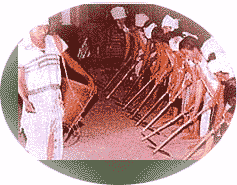Festivals Of Karbis
Festivals of the Karbis
Among the festivals observed by the Karbis, mention may be made of the “Chojun Puja” or “Swarak Puja” ;“Rongker”; “Sok-keroi”; “Hacha-Kekan”, “Chomangkan” , etc. While the former four festivals are socio-religious in nasture and the letter is a social one.
The spot for “Chojun Puja” or “Swarak Puja” is generally selected near the house of the family which wishes to perform the puja. The deities in this festival are Barithe, Shar Arnam, Arni and the Devil Hi-i and other smaller Gods. Hemphu, the greatest God of the Karbis is also propriated.The puja is peformed for the welfare of the family.
Rongker is performed at the beginning of the new year by propitiating the different gods and goddesses for the well being of the entire village. The deities are worshipped by all the elderly male people of the village so that with their blessings the people of the village could be free from diseases, natural calamities during the year and the families could have a good harvest. The women are not allowed to enter into the worship arena.
There is an another kind of Rongker performed in a greater scale. This type of Rongker which is performed at the beginning of every 5 years is called Wofong Rongker. This Wofong Rongker is performed for the well-being of all the people of the villages that fall within the jurisdiction of a Mauza (a revenue administrative region consisting of a number of revenue villages). Each revenue village is represented by the village headman and a number of village elders (males only) in the performance of the Wofong Rongker. While the Rongker performed for a village is only of one day’s duration, the Wofong Rongker continues for two days.
Sok-kerroi festival is observe when the paddy field is ripened to the fullest extent. The ripened paddy is cut and taken to a place specially cleared in the field. Then the paddy is dehusked on the floor and the paddy is collected. A large number of youngmen go and collect paddy in bags and carry it to home. There starts a great rejoicing and the young ones dance to their hearts’ context. Sok-erroi means the carrying of the paddy from the field. In the festival, one person is selected as the leader who provides the leadership in dancing and singing. He is called ‘LUNSE”. He is the director of singing and dancing.
The Hacha-Kekan is not exactly based on the folk-tales.Hacha-Kekan festival is associated with the after harvest rejoicings. There is no fear element in it and there is no need to propitiate any god. Hence it is to be assumed that the Hacha-Kekan is secular in its activities and differs substantially from another festival - RONGKER. Because, the latter needs the propitiation of god.
Although, the Karbis perform the funeral ceremony at the time of the cremation of the deceased, they also perform the death ceremony called “Chomangkan” at a later date for the eternal peace of the deceased. It is the most elaborate and expensive socio-religious ceremony of the Karbis which containues for four days and four nights non-stop.The ceremony does not require any formal invitation and all are welcome to it. In spite of the sad undertone, it is the proud day for the family and they welcome all with great warmth. They come in batches and everyone carries a symbolical rod with 5(five) branches and at the end of each branch, there is a wooden bird, which is called in Karbi “Vo-rali”. The whole rod is called “Jambili Athan”. This is the symbolical representation of the tribe and it is also the symbol of clan unity.
Photo Above:-Jambili Athon
The Jambili is a very interesting phenomenon. The tribe has five Kurs or clans and the Jambili has five branches. Under the cover of it, the Karbis listen the story of their origin. It is called “Muchera Kehir”.
| RONGKER & CHOMANGKAN | |||||||
| |||||||
| Blue and lusty green hills, covered with mist, the giggling springs, fragrance of wild flowers, and the call of the cuckoos have made Karbi Anglong the peaceful abode of the Karbis, the Mongoloid group who migrated to this land several hundred years BC. Karbis are very peace loving people. | |||||||
| |||||||
| On the other hand, Chomangkan is a festival, dedicated to the dead. It is primarily a death ceremony. It depends upon the convenience of the locality. This festival is a must for every Karbi. It is a non-stop four days rituals |



0 Comments:
Post a Comment
<< Home